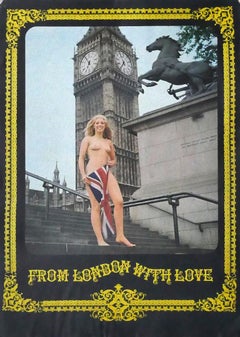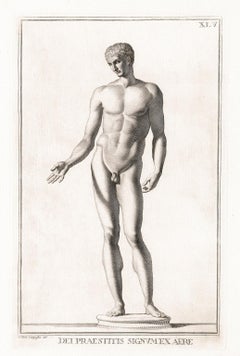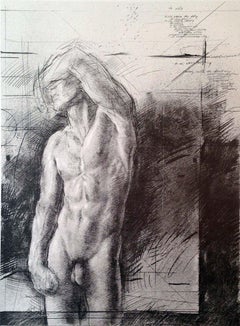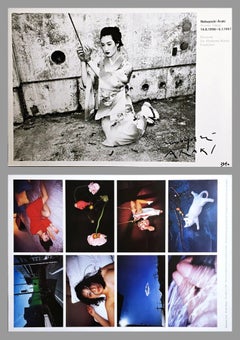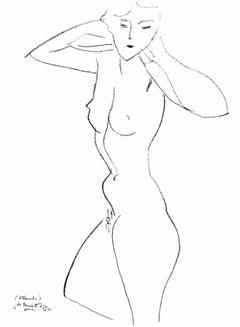Unframed Nude Prints
to
203
912
370
463
107
89
Overall Width
to
Overall Height
to
542
497
207
153
57
56
36
17
16
10
6
6
1
82
56
51
47
31
14
46
1,492
389
14
61
90
96
41
97
171
410
214
87
12
1,280
620
35
1,440
900
702
556
353
330
322
295
203
71
57
48
46
39
37
36
34
33
26
25
716
572
294
165
109
281
695
936
868
Frame Included
From London With Love - Offset Poster - 1980
Located in Roma, IT
From London With Love is an original offset of 1980.
There is The state of preservation of the artwork is very good.
Sheet dimension :88 x 61.5 cm
The poster represents a nude wom...
Category
1980s Figurative Prints
Materials
Offset
Erotic Scene - Héliogravure by Micheal Von Zichy - 1911
Located in Roma, IT
Erotic scene is an original Héliogravure artwork on ivory-colored paper, realized by Micheal Von Zichy in 1911. Printed in only 300 copies, Leipzig; Privatdruck, from the Catalogue ...
Category
1910s Modern Figurative Prints
Materials
Paper, Engraving
'Dei Praestitis Signumexaere' — 18th Century Classical Italian Realism
Located in Myrtle Beach, SC
Giovanni Domenico Campiglia, 'Dei Praestitis Signumexaere' (God's Providence Signumexaere), engraving, 1734, edition unknown. Signed 'Dom. Campiglia del.' in the plate, lower left. E...
Category
1730s Realist Nude Prints
Materials
Engraving
Rising I, Male nude lithograph by Trevor Southey
Located in Palm Springs, CA
Male nude lithograph by Trevor Southey. Charcoal gray. There was also an edition done in terra cotta.
Trevor Southey was born in Rhodesia, Africa (now Zimbabwe) in 1940. His African...
Category
1980s Contemporary Nude Prints
Materials
Lithograph
Private Tokyo, rare dazzling two sided nude signed 26/50 museum photo lithograph
Located in New York, NY
Nobuyoshi Araki
Private Tokyo, 1996
Two Sided Offset Lithograph
Boldly signed and numbered 26/50 by the artist in black marker on the lower right front
33 × 46 3/5 inches
Published b...
Category
1990s Contemporary Portrait Prints
Materials
Lithograph, Offset
Henri Matisse, Claude, Nude Woman, from Derriere le Miroir, 1952 (after)
Located in Southampton, NY
This exquisite lithograph after Henri Matisse (1869–1954), titled Claude, Femme nue (Claude, Nude Woman), originates from the 1952 folio Derriere le Miroir, No. 46–47, published by M...
Category
1950s Modern Figurative Prints
Materials
Lithograph
$716 Sale Price
20% Off
Women Bathing — German Expressionism, Nudes, 1920
Located in Myrtle Beach, SC
Georg Gelbke, Untitled (Women Bathing), etching, 1920. Signed and dated in pencil. Initialed and dated in the plate, lower right. A fine, richly-inked im...
Category
1920s Expressionist Nude Prints
Materials
Etching
$520 Sale Price
20% Off
Madman's Drum (Brothel) — 'Story Without Words' Graphic Modernism
By Lynd Ward
Located in Myrtle Beach, SC
Lynd Ward, 'Madman's Drum, Plate 41', wood engraving, 1930, edition small. Signed in pencil. A fine, richly-inked impression, on off-white tissue-thin Japan paper; the full sheet with margins (1 5/8 to 2 1/2 inches); a small paper blemish in the upper right margin, away from the image, otherwise in excellent condition. A scarce, artist-printed, hand-signed proof impression before the published edition. Matted to museum standards, unframed.
Image size 5 1/2 x 3 3/4 inches (140 x 95 mm); sheet size 9 5/8 x 7 1/8 inches (244 x 181 mm).
From Lynd Ward’s book of illustrations without words, 'Madman’s Drum', Jonathan Cape and Harrison Smith, New York, 1930.
Reproduced in 'Storyteller Without Words, the Wood Engravings of Lynd Ward', Harry N. Abrams, New York, 1974.
ABOUT THE ARTIST
Lynd Ward is acknowledged as one of America’s foremost wood engravers and book illustrators of the first half of the twentieth century. His innovative use of narrative printmaking as a stand-alone storytelling vehicle was uniquely successful in reaching a broad audience. The powerful psychological intensity of his work, celebrated for its dynamic design, technical precision, and compelling dramatic content, finds resonance in the literature of Poe, Melville, and Hawthorne. Like these classic American writers, Ward was concerned with the themes of man’s inner struggles and the role of the subconscious in determining his destiny. An artist of social conscience during the Great Depression and World War II, he infused his graphic images with his unique brand of social realism, deftly portraying the problems that challenged the ideals of American society.
The son of a Methodist preacher, Lynd Ward, moved from Chicago to Massachusetts at an early age. He graduated from the Teachers College of Columbia University, New York, in 1926, where he studied illustration and graphic arts. He married May Yonge McNeer in 1936 and left for Europe for their honeymoon in Eastern Europe. After four months, they settled in Leipzig, where Ward studied at the National Academy of Graphic Arts and Bookmaking. Inspired by Belgian expressionist artist Frans Masereel's graphic novel ‘The Sun,’ and another graphic novel by the German artist Otto Nückel, ‘Destiny,’ he determined to create his own "wordless" novel. Upon his return to America, Ward completed his first book, ‘God's Man: A Novel in Woodcuts,’ published in 1929. ‘Gods’ Man’ was a great success for its author and publisher and was reprinted four times in 1930, including a British edition. This book and several which followed it, ‘Madman’s Drum,’ 1930, ‘Wild Pilgrimage...
Category
1930s American Modern Figurative Prints
Materials
Woodcut
Mel Ramos, Original Exhibition Poster, 1972, Galerie Bischofberger
By Mel Ramos
Located in Hamburg, DE
Original poster for the exhibition "Mel Ramos" at Galerie Bischofberger in Zürich in 1972.
Category
20th Century Pop Art Nude Prints
Materials
Offset
Erotic Scene - Héliogravure by Micheal Von Zichy - 1911
Located in Roma, IT
Erotic scene is an original Héliogravure artwork on ivory-colored paper, realized by Micheal Von Zichy in 1911. Printed in only 300 copies, Leipzig; ...
Category
1910s Modern Figurative Prints
Materials
Paper, Engraving
"La Toilette" original etching
Located in Henderson, NV
Medium: original etching and drypoint. This impression on wove paper was printed in 1908 and published in Paris by the Revue de l'Art ancien et moderne. Plate size: 8 x 5 1/2 inches ...
Category
Early 1900s Nude Prints
Materials
Etching
On the Beach : Bather in the Wind - Original wooodcut, Handsigned
Located in Paris, IDF
Jean Baptiste VETTINER (1871-1935)
On the Beach : Bather in the Wind, 1928
Original woodcut
Handsigned in pencil
Numbered /160
On vellum 32.5 x 25.5 cm (c. 13 x 10 in)
Bears the bli...
Category
1920s Art Deco Nude Prints
Materials
Woodcut
Reclining Nude.
By Reza Yahyaei
Located in Berlin, MD
Reza Yahyaei (born 1948, France). Reclining nude female against bold color strokes. Matisse like simplicity of lines. A very striking piece, unframed...
Category
Mid-20th Century Abstract Impressionist Nude Prints
Materials
Lithograph
Modernist Nude — Atelier 17
Located in Myrtle Beach, SC
Russell T. Limbach, 'Untitled (Modernist Nude)', etching and aquatint, no known edition, c. 1930. Signed in pencil. A fine impression, on cream wove paper, with full margins (1 7/8 to 2 3/4 inches), in excellent condition. Image size 8 15/16 x 5 15/16 inches; sheet size 13 3/8 x 10 1/4 inches. Extremely rare. Matted to museum standards, unframed.
Probably created when Limbach was in Paris (1928-1934), where he was exposed to modernist printmaking explorations at Stanley William Hayter’s 'Atelier 17'.
ABOUT THE ARTIST
Born in Massillon, Ohio, Russell Limbach...
Category
1930s American Modern Nude Prints
Materials
Etching
Kate II - Oversize limited edition - Kate Moss
Located in London, GB
Kate II - Oversize limited edition - Kate Moss
Beautiful archival pigment print of the supermodel and fashion icon
by the London based contemporary pop art
image creator and artist...
Category
2010s Pop Art Figurative Prints
Materials
Black and White, Archival Pigment
Erotic Scene - Héliogravure by Micheal Von Zichy - 1911
Located in Roma, IT
Erotic scene is an original Héliogravure artwork on ivory-colored paper, realized by Micheal Von Zichy in 1911. Printed in only 300 copies, Leipzig; Privatdruck, from the Catalogue ...
Category
1910s Modern Figurative Prints
Materials
Paper, Engraving
Original Bergasol vintage poster Villemot Sunscreen
Located in Spokane, WA
Original vintage poster: Bergasol. Artist: Bernard Villemot Professional mounted on acid-free archival linen. Ready to frame. In very fine condition.
The Bergasol poster i...
Category
1970s Pop Art Nude Prints
Materials
Offset
"La Femme et la Folie Dominent le Monde II" - 1886 Print on Paper
Located in Soquel, CA
"La Femme et la Folie Dominent le Monde II" - 1886 Print on Paper
("The Woman and the Madness Overlooking The World II")
1886 French illustration from Felicien Rops (Belgian, 1833-...
Category
1880s Impressionist Figurative Prints
Materials
Etching, Paper, Ink
The Hat : Dressed with Nothing - Original signed lithograph - Mourlot, 1956
Located in Paris, IDF
Jean-Gabriel DOMERGUE
The Hat : Dressed with Nothing, 1956
Original lithograph (Mourlot workshop)
Printed signature in the plate
On Japan paper 40 x 31 cm (c. 16 x 12")
INFORMATION...
Category
1950s Modern Nude Prints
Materials
Lithograph
From the Vargas Portfolio
Located in Missouri, MO
From the Vargas Portfolio **Portfolio Cover Not Included**
Lithograph Only
Alberto Vargas (1896-1982) was born in Arequipa, Peru, in 1896, the son of...
Category
20th Century Realist Nude Prints
Materials
Lithograph
Geisha Skateboard Triptych(suite of three silkscreen skateboards numbered 55/150
Located in New York, NY
Nobuyoshi Araki
Geisha Skateboard Triptych, ca. 2014
Set of (3) Skateboards of Silkscreen on 7 ply Canadian Maplewood Deck
Signed in plate, Each signed on the deck and hand numbered ...
Category
2010s Contemporary Nude Prints
Materials
Wood, Maple, Screen
Salvador Dali - Knight & Death, from "Faust"
Located in Collonge Bellerive, Geneve, CH
Salvador Dali - "Knight & Death" from Faust - Original Etching
With embossed signature (from the standard book edition of 731)
Dimensions: 38,5 x 28,5 cm
1969
References : Field 69-1...
Category
1960s Surrealist Nude Prints
Materials
Etching
Male Nude 6, Photorealist Lithograph by Lowell Blair Nesbitt
Located in Long Island City, NY
This provocative portrayal of a male nude figure by Lowell Blair Nesbitt is very different from many of his other works featuring floral decoration and close-up depictions of flowers...
Category
1970s Photorealist Nude Prints
Materials
Lithograph
Hav a Havana #10, Pop Art Lithograph by Mel Ramos
By Mel Ramos
Located in Long Island City, NY
Artist: Mel Ramos, American (1935 - 2018)
Title: Hav a Havana #10
Year: 2015
Medium: Lithograph, signed and numbered in pencil
Edition: 199
Image Size: 22.25 x 36.5 inches
Size: 29.2...
Category
2010s Pop Art Nude Prints
Materials
Lithograph
Sex Theme - Etching by Charkes Laborde - Early 20th Century
Located in Roma, IT
Etching hand colored by Chas Laborde, realized to illustrate "Les Chansons Erotiqies" by Pierre-Jean Beranger.
Realized in the early 20th Century.
Very good condition.
Category
Early 20th Century Modern Figurative Prints
Materials
Etching
Original Cycles Clement Motocycles Belle Epoque vintage poster
Located in Spokane, WA
Original French poster: Cycles Clement Motocycles, La Plus Vaste Usine de Monde; artist: PAL, (Jean de Paléologue) 1860-1942, c. 1895 original stone lithograph; archival linen backe...
Category
1890s Art Nouveau Nude Prints
Materials
Lithograph
Feminaire II, Surrealist Etching by André Masson
By André Masson
Located in Long Island City, NY
André Masson, French (1896 -1987) - Feminaire II, Year: 1951, Medium: Etching on wove paper, signed and numbered in pencil, Edition: 30, Image Size: 9.75 x 8 inches, Size: 14.25...
Category
1950s Surrealist Nude Prints
Materials
Etching
Nude /// Contemporary Pop Art Screenprint Colorful Figurative Reclining Print
By Dan May
Located in Saint Augustine, FL
Artist: Dan May (American, 1955-)
Title: "Nude"
*Signed and numbered by May in pencil lower left
Year: 1987
Medium: Original Screenprint on unbranded soft-cream wove paper
Limited ed...
Category
1980s Contemporary Nude Prints
Materials
Screen
Shunga - Woodcut attr. Keisai Eisen - Mid-19th Century
By Keisai Eisen
Located in Roma, IT
Woodcut shunga print attributed to Keisai Eisen and realized in the early 19th century.
Good condition except for some signs of time.
Category
Mid-19th Century Modern Figurative Prints
Materials
Woodcut
Keith Haring Crack Down! (Keith Haring 1986)
By Keith Haring
Located in NEW YORK, NY
Keith Haring Crack Down! 1986:
Vintage original Keith Haring anti-drug poster, 1986.
Off-set lithograph on heavy weight paper.
Dimensions: 17 x 22 inches.
Minor signs of handling; ...
Category
1980s Street Art Figurative Prints
Materials
Lithograph, Offset
$375 Sale Price
28% Off
'Baigneuse Debout, à Mi-Jambes' — French Impressionism
Located in Myrtle Beach, SC
Pierre Auguste Renoir, 'Baigneuse Debout, à Mi-Jambes (Woman Bathing, Standing Up to Her Knees in Water)', 1910, etching, edition not stated, Delteil 23. Unsigned as published. A fin...
Category
1910s Impressionist Nude Prints
Materials
Etching
$600 Sale Price
20% Off
Challenge, male nude by Trevor Southey
Located in Palm Springs, CA
This evocative etching portrays a male nude seen from behind, his arm extended upward in a powerful yet graceful gesture. The figure’s musculature is rendered with classical precisio...
Category
1990s Contemporary Nude Prints
Materials
Etching
Mermaid - Original Lithograph - 1897
By Charles François Prosper Guérin
Located in Paris, IDF
Charles GUERIN
Mermaid, 1898
Original lithograph (Champenois workshop)
Printed signature in the plate
On vellum, 40 x 31 cm (c. 16 x 12 in)
INFORMATION: Lithograph created for the ...
Category
1890s Art Nouveau Nude Prints
Materials
Lithograph
Shiny Nude (Stealingworth, 33) silkscreen on kromekote paper + envelope AP/1000
Located in New York, NY
Tom Wesselmann
Shiny Nude (Stealingworth, 33), 1977
Silkscreen on glossy cast-coated Kromekote paper
8 × 8 inches
Edition of 1000 (AP/1000)
Pencil numbered ...
Category
1970s Pop Art Nude Prints
Materials
Screen, Paper
Nude - Lithograph by Andrè Derain - 1929
By André Derain
Located in Roma, IT
Nude is a modern artwork realized by Andrè Derain in Early 20th century.
Lithograph on simili-Japan paper.
Realized for "Les Travaux et les Jeux" by Vincent Muselli. Published by J...
Category
1920s Modern Figurative Prints
Materials
Lithograph
Salvador Dali - Erotic Grapefruit - Original Hand-Signed Lithograph
Located in Collonge Bellerive, Geneve, CH
Salvador Dali - Erotic Grapefruit - Original Hand-Signed Lithograph
1969
Dimensions: P. 57 x 37 cm
Sheet: 75 x 56 cm
Handsigned, EA (Epreuve d'Artiste)
Excellent Condition
Reference...
Category
1960s Surrealist Still-life Prints
Materials
Lithograph
lithograph for Florilege des amours de Ronsard
Located in Henderson, NV
Medium: lithograph (after the the original lithograph). Printed in sanguine ink on cream laid paper from the Papeteries Casteljoux and published in Geneva by Edito-Service in 1970. T...
Category
1970s Nude Prints
Materials
Lithograph
Venus, Mars and Cupid
Located in Washington, DC
Artist: Salvador Dali
Title: Venus, Mars and Cupid
Medium: Engraving with stencil color on Rives paper
Year: 1971
Edition: 81/150
Sheet Size: 29 5/8" x 22"
Image Size: 22 3/4" x 15"
...
Category
1970s Surrealist Figurative Prints
Materials
Lithograph
Mel Ramos, Peek-A-Boo Marilyn 1 - Original Lithograph, Signed Pop Art Print
By Mel Ramos
Located in Hamburg, DE
Mel Ramos (American, 1935-2018)
Peek-A-Boo Marilyn 1, 2002
Lithograph on wove paper
31 1/2 × 23 in 80 × 58.5 cm
Edition of 199: Hand-signed and numbered
Condition: Excellent
Category
21st Century and Contemporary Pop Art Figurative Prints
Materials
Lithograph
Brunelleschi, Composition, La Leçon d'amour dans un parc (after)
Located in Southampton, NY
Lithograph and stencil on vélin d’Arches paper. Unsigned and unnumbered, as issued. Good condition. Notes: From the volume, La Leçon d'amour dans un parc, 1933. Published by Éditions...
Category
1930s Modern Nude Prints
Materials
Lithograph, Stencil
$1,436 Sale Price
20% Off
original etching
Located in Henderson, NV
Medium: original etching. This impression on wove paper was printed in 1968 and published in Paris for the Humanisme actif portfolio. Plate size: 8 1/4 x 6 inches (210 x 153 mm). Sig...
Category
1960s Nude Prints
Materials
Etching
"Firestarter" Black & White Photography Edition 3/7 32" x 24" in by Lukas Dvorak
By Lukas Dvorak
Located in Culver City, CA
"Firestarter" Black & White Photography Edition 3/7 32" x 24" in by Lukas Dvorak
Pigment print on Epson Fine ART paper
2021
Unframed
Ships rolled in a tube
ABOUT THE ARTIST
...
Category
21st Century and Contemporary Contemporary Nude Photography
Materials
Archival Paper, Pigment
Stefanie 2 by Peter Handel - Giclée Art Print
By Peter Handel
Located in Winterswijk, NL
Stefanie 2, a stunning giclée print by renowned artist Peter Handel. Printed on premium Hahnemühle Velvet paper and hand-signed, this artwork is a high-quality reproduction of the or...
Category
21st Century and Contemporary Nude Prints
Materials
Paper
Nude Figure in Red
Located in Soquel, CA
Nude in Red, a collotype figure study by Patricia A. Pearce (American, b. 1948). Unframed. Signed "PP" on verso. Image: 8.5"H x 7.75"W.
Patricia Pearce was a California artist and a...
Category
1980s Expressionist Nude Prints
Materials
Paper, Ink, Color
$399 Sale Price
20% Off
Le Printemps, Modern Drypoint Etching by Auguste Rodin
Located in Long Island City, NY
Auguste Rodin, French (1840 - 1917) - Le Printemps, Year: 1882-1888, Medium: Drypoint Etching, Image Size: 5.75 x 4 inches, Size: 16.25 x 11.25 in. (41.28 x 28.58 cm), Reference: T...
Category
1880s Modern Nude Prints
Materials
Drypoint, Etching
Salvador Dali - Nude and Lobster
Located in Collonge Bellerive, Geneve, CH
Salvador Dali - Nude and Lobster - Original Etching
Dimensions: 38 x 28 cm
Edition: 390
1967
Editor : Au Cercle du Livre Précieux
On Rives Vellum
From the Serie Casanova
Unsigned as ...
Category
1960s Surrealist Nude Prints
Materials
Etching
Keith Haring Help the Homeless 1985 (Keith Haring 1985 announcement)
By Keith Haring
Located in NEW YORK, NY
Keith Haring 1985:
Keith Haring off-set illustrated announcement card, NY, 1985: "NY for NY, Help The Homeless" at The Roxy, West 18th St., NYC.
Off-set printed, 1985 (folds open in...
Category
1980s Pop Art Nude Prints
Materials
Offset, Lithograph
David Hockney, Untitled (from Geh durch den Spiegel): Male Nude, Original Print
Located in Hamburg, DE
David Hockney
Untitled (from Geh durch den Spiegel), 1966
Medium: Lithograph on paper
Dimensions: 14 7/10 × 10 1/10 in (37.3 × 25.6 cm)
Edition of 250: Not signed, not numbered
Condi...
Category
20th Century Contemporary Figurative Prints
Materials
Lithograph
Overture Sur L'Ete 1981 Signed Limited Edition Lithograph
Located in Rochester Hills, MI
Guillaume Corneille
Summer 1981
Overture Sur L'Ete
Print, Signed Lithograph on wove paper
25.5 x 20 " inches
Signed in pencil and dated and marked AP 16/25 ( Artist Proof )
As a ...
Category
1980s Abstract Nude Prints
Materials
Lithograph
Tom Cruise Penis [3]: Study for The Shroud of Scientology
Located in Santa Monica, CA
Unframed print, artist proof.
Category
2010s Contemporary Nude Prints
Materials
Digital
$288 Sale Price
40% Off
"Genesis" Ballet Photography 36" x 27" in Edition 5/25 by Yevgeniy Repiashenko
Located in Culver City, CA
"Genesis" Ballet Photography 36" x 27" in Edition 5/25 by Yevgeniy Repiashenko
Photography
Year photo was taken: 2019
Unframed - ships in a tube
This picture is a part of Spiri...
Category
21st Century and Contemporary Contemporary Nude Prints
Materials
Photographic Paper, Archival Pigment
Henri Matisse, The Sorrow of the King, Verve, Revue Artistique, 1958 (after)
Located in Southampton, NY
This exquisite lithograph after Henri Matisse (1869–1954), titled La Tristesse du Roi (The Sorrow of the King), from Verve, Revue Artistique et Litteraire, Vol. IX, No. 35–36, origin...
Category
1950s Modern Landscape Prints
Materials
Lithograph
$1,036 Sale Price
20% Off
Leaves of Love-Orange Lady plus Mermaid (two proof prints)
Located in Middletown, NY
A colorful, myth-based female nude along with a portriat of a mermaid by the same artist.
Lithograph in color on white wove paper, 18 1/4 x 11 3/4 inches (462 x 297 mm), full margin...
Category
Mid-20th Century Modern Nude Prints
Materials
Lithograph
The Birth of Venus - Original lithograph and watercolor
By Joseph Felon
Located in Paris, IDF
Joseph FELON (1818 - 1897)
The Birth of Venus
Original stone lithograph, enhanced with watercolor
Printed signature in the plate
On paper 33 x 50 cm (c. 12.9 x 19.6 inch)
Very good...
Category
Late 19th Century Art Nouveau Nude Prints
Materials
Watercolor, Lithograph
Musizierender Faun, Modern Nude Lithograph by Oskar Kokoschka
Located in Long Island City, NY
Oskar Kokoschka, Austrian (1886 - 1980) - Musizierender Faun, Year: 1976, Medium: Lithograph on laid paper, signed and numbered in pencil, Edition: 100, Image Size: 10.25 x 8 inche...
Category
1970s Modern Nude Prints
Materials
Lithograph
Keith Haring Into 84 (Keith Haring Tony Shafrazi announcement card)
By Keith Haring
Located in NEW YORK, NY
Keith Haring Painted Man:
Original 1983 announcement card for Keith Haring’s well-documented exhibition, Keith Haring 'Into 84' at Tony Shafrazi Gallery, New York, 1983. For this series Haring borrowed Jones' body — from head to toe — as the canvas to his work. A bodily canvas defined by much of the bold pictograms characteristic of Haring's artistic signature. Photos by Haring's long-time friend and collaborator Tseng Kwong Chi.
Off-set printed, 1983.
Dimensions: 6 x 4 inches.
Some minor fading to the reverse; otherwise very good overall condition with strong colors.
Literature: Keith Haring: Posters (Prestel pub.)
Further About
In 1983 Keith Haring teamed up with award-winning choreographer and dancer Bill T. Jones, founder of the Bill T. Jones/Arnie Zane Dance Company. Keith and Bill met in London in 1983 at a time when the graffiti artist was opening a major show at the Robert Fraser Gallery, and together they produced a series of exceptional collaborations in both performance and drawing.
Related Categories
Keith Haring dancer. Ballet. Keith Haring Figurative Drawings. Keith Haring Into 84 poster. Keith Haring and Tony Shafrazi. Haring Shafrazi.
Category
1980s Pop Art Nude Prints
Materials
Offset, Lithograph
Untitled (INV# NP5778) by Ken Price
By Ken Price
Located in Morton Grove, IL
Ken Price (1935-2012)
screenprints in colors on Arches France paper
14 x 11”
signed and dated in pencil
stamped by Ken Price and Black Sparrow Graphic Arts
edition of 170, # 45/170
...
Category
1990s Contemporary Nude Prints
Materials
Screen
"La tête" Nude Art Print 38" x 47" inch Edition of 15 by Yevgeniy Repiashenko
Located in Culver City, CA
"La tête" Nude Art Print 38" x 47" inch Edition of 15 by Yevgeniy Repiashenko
Year photo was taken: 2014
Art Print
Limited Edition of 15
Picture size:
Height: 38" inch
Width: 47" i...
Category
21st Century and Contemporary Contemporary Nude Photography
Materials
Photographic Paper, Pigment
Portrait Imaginare 1981 Signed Limited Edition Lithograph
Located in Rochester Hills, MI
Guillaume Corneille
Portrait Imaginare 1981
Print, Signed Lithograph on wove paper
25.5 x 19.5 " inches
Signed in pencil and dated and marked 200/200
As a co-founder of the famed ...
Category
1980s Abstract Nude Prints
Materials
Lithograph
Lovers - 2000s - Lithograph - Modern Art
Located in Roma, IT
Lovers is a superb and original colored lithograph from the portfolio "Erotica" by Egon Schiele.
It deals with a reproduction of the homonym artwork realized in gouache, watercolor, ...
Category
Early 2000s Modern Nude Prints
Materials
Lithograph
